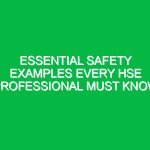Introduction to Our Toolbox Talk
Good morning, team! Before we dive into our daily tasks, I want to take a moment to discuss an essential topic: What Can Hurt Me Today? This Toolbox Talk is designed to help us all recognize potential Hazards and understand how we can work safely in our Environment. As we go through our day, it’s crucial to be aware of the risks that could affect us and our coworkers. By the end of this session, you’ll have a clearer idea of what to look out for and how to mitigate those risks. Let’s get started!
Understanding the Concept: What Can Hurt Me Today?
The phrase What Can Hurt Me Today? serves as a daily reminder to assess our surroundings and identify potential Hazards. It’s not just about physical dangers but also includes mental and emotional stressors that can impact our performance and Safety. For example, fatigue from a long day or personal issues can distract us and lead to accidents. That’s why taking a moment to evaluate our situation each day is critical.
The Importance of Awareness
Awareness is our first line of defense against accidents. By consistently asking ourselves What Can Hurt Me Today?, we stay vigilant and proactive. This approach helps us create a culture of Safety where everyone feels responsible for their well-being and that of their teammates.
Key Hazards to Consider
Let’s break down some of the common hazards you might encounter in our workplace:
- Slips, Trips, and Falls: Uneven surfaces, spills, or clutter can easily lead to accidents.
- Manual Handling: Incorrect lifting techniques can cause serious injuries. Always remember to lift with your legs, not your back.
- Machine Operation: Operating machinery without proper Training or Safety Gear can pose significant risks.
- Chemical Exposure: Ensure you understand the Material Safety Data Sheets (MSDS) for any chemicals you may encounter.
- Fatigue and Stress: Mental well-being is just as important as physical safety. Be mindful of how you’re feeling.
Real-Life Examples of Hazards
Let’s consider a couple of scenarios. Imagine a team member working near a machine without proper guards in place. This situation could lead to severe injuries. In another example, think about someone who is exhausted after a long shift—this fatigue can reduce concentration and lead to mistakes. Both scenarios illustrate the importance of regularly assessing our environment and personal state.
How to Conduct a Daily Safety Check
Incorporating a daily safety check into your routine can significantly reduce risks. Here’s a simple process you can follow:
- Look Around: Take a moment to scan your work area for any potential hazards.
- Assess Risks: Identify what could go wrong. Ask yourself, What Can Hurt Me Today?
- Take Action: If you notice a hazard, address it immediately. If it’s beyond your control, report it to a supervisor.
- Communicate: Share your observations with your teammates. A supportive environment helps everyone stay safe.
Best Practices for Staying Safe
Now that we’ve discussed hazards and daily checks, let’s go over some Best Practices to keep in mind:
- Wear Personal Protective Equipment (PPE): Always use the required PPE for your tasks, whether it’s hard hats, gloves, or Safety Goggles.
- Follow Procedures: Stick to established safety procedures and don’t take shortcuts.
- Stay Hydrated: Especially in hot conditions, drink plenty of water to maintain focus and prevent fatigue.
- Take Breaks: Regular breaks can help refresh your mind and body, reducing the risk of accidents.
Identifying and Reporting Hazards
It’s essential to be proactive in identifying hazards. If you see something concerning, report it to your supervisor or safety officer immediately. Remember, it’s not just about your safety but also the safety of your coworkers. Your vigilance can prevent an accident before it happens.
Regulations and Standards
Understanding Regulations and standards related to health and safety is crucial. Our company adheres to guidelines set forth by the Occupational Safety and Health Administration (OSHA) and other relevant authorities. Compliance with these regulations is not just a legal obligation; it’s a commitment to a safe workplace.
The Impact of Non-Compliance
Non-compliance can lead to severe repercussions, including fines, legal action, and increased accident rates. More importantly, it can endanger lives. By following safety protocols, we protect ourselves and our organization.
Emotional and Mental Well-Being
While we often focus on physical hazards, we must not overlook emotional and mental well-being. Stress, anxiety, and burnout can significantly impact performance and safety. If you’re feeling overwhelmed, don’t hesitate to reach out for support. It’s essential to talk about how you’re feeling, whether with a supervisor or a trusted colleague.
Creating a Supportive Environment
Encouraging open discussions about mental health can foster a supportive environment. Consider implementing regular check-ins or team-building activities that promote well-being. Remember, a safe workplace is one where everyone feels comfortable expressing their concerns.
Conclusion: Your Role in Safety
As we wrap up today’s Toolbox Talk, remember that safety is a shared responsibility. By consistently asking What Can Hurt Me Today?, we can create a proactive safety culture. Take the insights we’ve discussed today and apply them to your daily routine. Your commitment to safety not only protects you but also your coworkers.
Thank you all for your attention and dedication to maintaining a safe work environment. Let’s make sure we look out for one another, and make safety our priority every day!


